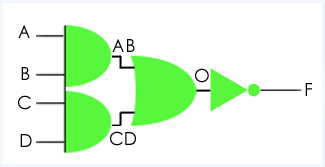Shown below is a second architecture V2 of AOI (remember that the architecture name V2 is completely arbitrary - this architecture is called V2 to distinguish it from the earlier architecture V1). Architecture V2 describes the AOI function by breaking it down into the constituent boolean operations. Each operation is described within a separate concurrent signal assignment. In hardware terms we can think of each assignment as a die in a hybrid package or a multi-chip module. The signals are the bonding wires or substrate traces between each die.
VHDL: Internal signals of an AOI gate

library IEEE; use IEEE.STD_LOGIC_1164.all; entity AOI is port (A, B, C, D: in STD_LOGIC; F : out STD_LOGIC); end AOI; architecture V2 of AOI is signal AB, CD, O: STD_LOGIC; begin AB <= A and B after 2 NS; CD <= C and D after 2 NS; O <= AB or CD after 2 NS; F <= not O after 1 NS; end V2;
Signals
The architecture contains three signals AB, CD and O, used internally within the architecture. A signal is declared before the begin of an architecture, and has its own data type (eg. STD_LOGIC). Technically, ports are signals, so signals and ports are read and assigned in the same way.
Assignments
The assignments within the architecture are concurrent signal assignments. Such assignments execute whenever a signal on the right hand side of the assignment changes value. Because of this, the order in which concurrent assignments are written has no effect on their execution. The assignments are concurrent because potentially two assignments could execute at the same time (if two inputs changed simultaneously). The style of description that uses only concurrent assignments is sometimes termed dataflow.
Delays
Each of the concurrent signal assignments has a delay. The expression on the right hand side is evaluated whenever a signal on the right hand side changes value, and the signal on the left hand side of the assignment is updated with the new value after the given delay. In this case, a change on the port A would propagate through the AOI entity to the port F, with a total delay of 5 NS.
Your e-mail comments are welcome - send email
Copyright 1995-2014 Doulos


